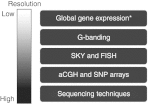Assessing the risks of genotoxicity in the therapeutic development of induced pluripotent stem cells
- PMID: 23207694
- PMCID: PMC3594024
- DOI: 10.1038/mt.2012.255
Assessing the risks of genotoxicity in the therapeutic development of induced pluripotent stem cells
Abstract
Induced pluripotent stem cells (iPSCs) have great potential for regenerative medicine as well as for basic and translational research. However, following the initial excitement over the enormous prospects of this technology, several reports uncovered serious concerns regarding its safety for clinical applications and reproducibility for laboratory applications such as disease modeling or drug screening. In particular, the genomic integrity of iPSCs is the focus of extensive research. Epigenetic remodeling, aberrant expression of reprogramming factors, clonal selection, and prolonged in vitro culture are potential pathways for acquiring genomic alterations. In this review, we will critically discuss current reprogramming technologies particularly in the context of genotoxicity, and the consequences of these alternations for the potential applications of reprogrammed cells. In addition, current strategies of genetic modification of iPSCs, as well as applicable suicide strategies to control the risk of iPSC-based therapies will be introduced.
Figures


References
-
- Takahashi K., and, Yamanaka S. Induction of pluripotent stem cells from mouse embryonic and adult fibroblast cultures by defined factors. Cell. 2006;126:663–676. - PubMed
-
- Ben-David U, Mayshar Y., and, Benvenisty N. Large-scale analysis reveals acquisition of lineage-specific chromosomal aberrations in human adult stem cells. Cell Stem Cell. 2011;9:97–102. - PubMed
-
- Livingstone LR, White A, Sprouse J, Livanos E, Jacks T., and, Tlsty TD. Altered cell cycle arrest and gene amplification potential accompany loss of wild-type p53. Cell. 1992;70:923–935. - PubMed
Publication types
MeSH terms
Grants and funding
LinkOut - more resources
Full Text Sources
Other Literature Sources

